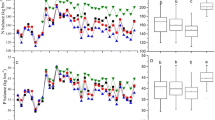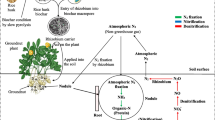Abstract
In order to reasonably and efficiently improve the soil fertility of newly built greenhouses, the effects of rapeseed returning to the field and applying biochar on soil carbon and nitrogen and subsequent crops were studied, and the optimal combination of green manure rapeseed and biochar was sought. The study designed four rape returning levels (fresh weight 7500, 15000, 22500, 45000 kg·hm−2) and two biochar application levels (0%, 1%), and no returning and no biochar application as controls, a total of nine treatments. The maximum increase in total carbon, light fraction organic carbon, dissolved organic carbon (DOC), microbial biomass carbon nitrogen, total nitrogen, heavy fraction organic nitrogen, and urease activity was observed in the F6 treatment, which significantly increased by 85.60%, 86.98%, 65.09%, 170.73%, 266.99%, 24.59%, 19.81%, and 26.16% compared to the basic soil, respectively. The maximum increase in soil heavy organic carbon was observed in F4 treatment. The maximum increase in soil light fraction organic nitrogen was observed in F5 treatment. In the correlation analysis between crop yield, total dry matter quality, nutrient absorption and soil C and N indicators, the correlation with soil urease activity, DOC, total carbon, and light fraction organic carbon is the highest. The treatment of 1% biochar and returning quantity 2.25 × 104 kg·hm−2 (F6) had the best effect on soil carbon and nitrogen, the most significant effect on dry matter quality, nutrient absorption and yield of subsequent crops, and the combination of 1% biochar and returning quantity 1.50 × 104 kg·hm−2 (F4) had the second effect. This study clarified the optimal amount of biochar and green manure combined in the process of soil fertility improvement in newly constructed greenhouses through the changes in soil carbon and nitrogen indicators, providing a reference for subsequent experiments and soil fertility improvement.


Similar content being viewed by others
References
Abhishek K, Srivastava A, Vimal V, Ak G, Sk B, Jk B, Singh L, Ghosh P, Pandey A, Sharma P, Kumar M (2022) Biochar application for greenhouse gas mitigation, contaminants immobilization and soil fertility enhancement: A state-of-the-art review. Sci Total Environ 853:158562. https://doi.org/10.1016/J.SCITOTENV.2022.158562
Bai XL, Gao JJ, Chen ZJ, Lei JF, Zhou JB (2014) Soil nutrient balance and accumulation characteristics in newly built solar greenhouses. Soils Fertilizers Sci Chin 1–5. https://doi.org/10.11838/sfsc.20140201.
Bao SD (2000) Soil Agricultural Chemistry Analysis. China Agriculture Press, Beijing. https://upimg.baike.so.com/doc/8966512-9294616.html. Accessed 18 Apr 2023
Bi YL, Zhang JY, Wang K, Du SZ (2022) Effects of green manure returning inoculation arbuscular mycorrhizal fungi and dark septal endophytic fungi on maize growth and nitrogen utilization. Chin J Soil Sci 53:890–896. https://doi.org/10.19336/j.cnki.trtb.2021042401
Bianca JS, Davi LC, Ricardo HSS, Teógenes SO, Raphael BAF (2019) Residual Contribution of Green Manure to Humic Fractions and Soil Fertility. J Soil Sci Plant Nutr 19:878–886. https://doi.org/10.1007/s42729-019-00086-z
Borchard N, Wolf A, Laabs V, Aeckersberg R, Scherer HW, Moeller A, Amelung W (2012) Physical activation of biochar and its meaning for soil fertility and nutrient leaching-greenhouse experiment. Soil Use Manage 28:0-0. https://doi.org/10.1111/j.1475-2743.2012.00407.x
Brookes PC, Landman A, Pruden G et al (1985) Chloroform fumigation and the release of soil nitrogen: Arapid direct extraction method for measuring microbial biomass nitrogen in soil. Soil Biol Biochem 17:837–842. https://doi.org/10.1016/0038-0717(85)90144-0
Cai SM, Zhu HT, Zhang DS, Fu ZS, Xu SX, Lv WG (2021) Effects of water and nitrogen interaction on soil nitrogen forms and bacterial community structure in protected vegetable fields. Chin J Soil Sci 52:99–108. https://doi.org/10.19336/j.cnki.trtb.2020063001
Chang DN, Cao WD, Bai JS, Gao SJ, Wang XC, Zeng NH, Katsuyoshi S (2017) Effects of Green Manures on Soil Dissolved Organic Matter in Moisture Soil in North China. Spectrosc Spectral Anal 37:221–6. https://doi.org/10.4141/s00-034
Chen JF, Liang H, Wang W, Chen H, Yin M (2021) Nitrogen substitution and soil fertility enhancement effects of light leaf purple blossom potato under maize green fertilizer rotation system. J Plant Nutr Fertilizers 27:1571–1580. https://doi.org/10.11674/zwyf.2021068
Cheng XY, Lan Y, Ren XF, Miao W, Yang X, Jiang LL, Liu SN, Chen WF (2017) Effects of biochar on soil enzyme activities and cucumber root characteristics in continuous cropping facilities. J Shenyang Agric Univ 48:418–423. https://doi.org/10.3969/j.issn.1000-1700.2017.04.005
Gao X, Peng YT, Zhou YY, Adeel M, Chen Q (2019) Effects of magnesium ferrite biochar on the cadmium passivation in acidic soil and bioavailability for packoi ( Brassica chinensis L.). J Environ Manage 251:109610. https://doi.org/10.1016/j.jenvman.2019.109610
Guan SY, Zhang DS, Zhang ZM (1986) Soil enzymes and their research methods. Agricultural Publishing House Beijing. https://www.docin.com/p-1557603287.html. Accessed 18 Apr 2023
Jama B, Palm CA, Buresh RJ, Niang A, Gachengo C, Nziguheba G, Amadalo B (2000) Tithonia diversifolia as a green manure for soil fertility improvement in western Kenya: A review. Agrofor Syst 49:201–221. https://doi.org/10.1023/A:1006339025728
Jaya N, Wiqar A, Fazal M, Aziz K, Zou ZY (2023) Advances and prospects of biochar in improving soil fertility, biochemical quality, and environmental applications. Front Environ Sci. https://doi.org/10.3389/FENVS.2023.1114752
Jiao H, Li YL, Gao JW, Li Y, He B, Li S (2018) Effects of fertilization measures on light recombinant organic carbon and nitrogen in reclaimed soil. J Soil Water Conserv 32:208–213+221. https://doi.org/10.13870/j.cnki.stbcxb.2018.05.034
Kamau S, Karanja NK, Ayuke FO, Lehmann J (2019) Short-term influence of biochar and fertilizer-biochar blends on soil nutrients, fauna and maize growth. Biol Fertil Soils 55:661–673. https://doi.org/10.1007/s00374-019-01381-8
Kenjaev Y, Davronova FP (2023) Study on the effect of the green manure application on soil fertility. IOP Conf Ser : Earth Environ Sci 1142. https://doi.org/10.1088/1755-1315/1142/1/012112.
Kloss S, Zehetner F, Wimmer B, Buecker J, Rempt F, Soja G (2014) Biochar application to temperate soils: Effects on soil fertility and crop growth under greenhouse conditions. J Plant Nutr Soil Sci 177:3–15. https://doi.org/10.1002/jpln.201200282
Lee BJ, Yoon TH, Cho WT, Jun HS, Cho YS (2013) Effects of Green Manure Cropping on Soil Biomass-C and Soil Fertility in Green House Soil. Kor J Organic Agric 21:647–657. https://doi.org/10.16257/GARJ/201313214
Lehmann J, Silva JPD, Steiner C, Nehls T, Zech W, Glaser B (2003) Nutrient availability and leaching in an archaeological Anthrosol and a Ferralsol of the Central Amazon basin: fertilizer, manure and charcoal amendments. Plant Soil 249:343–357. https://doi.org/10.1023/A:1022833116184
Liu J, Zhang J, Xu CX, Bai JS, Cao WD (2014) The effect of different returning pressures on soil fertility in february orchid. Agric Res Arid Areas 32:123–127. https://doi.org/10.7606/j.issn.1000-7601.2014.01.020
Liu XM, Song QJ, Tang Y, Li WL, Xu JM, Wu JJ, Wang F, Brookes PC (2013) Human health risk assessment of heavy metals in soil-vegetable system: A multi-medium analysis. Sci Total Environ 530–540. https://doi.org/10.1016/j.scitotenv.2013.06.064
Lu WH, Zhang NM, Bao L, Zhang L, Qin TF (2020) Research progress on the characteristics, causes, and control measures of continuous cropping obstacles in facility cultivation in China. Soils 52:651–658. https://doi.org/10.13758/j.cnki.tr.2020.04.001
Mukhtar AI ,Olalekan TK ,I. MA , et al (2022) Green manure for agricultural sustainability and improvement of soil fertility. Farm Manag 7:1–8. https://doi.org/10.31830/2456-8724.2022.FM-101.
Peng P, Liang L, Li HL, Zhao GS (2019) The current situation, problems and development suggestions of facility agriculture in China. North Hortic 161–168. https://doi.org/10.11937/bfyy.20181823.
Su S, Kang YY, Wang Y, Yuan LY, Zhong M, Sun J, Guo SR (2018) Overview, characteristics, and trend analysis of the development of facility horticulture in the world. Chin Veg 1–13. https://doi.org/10.19928/j.cnki.1000-6346.201807001
Sun J, Gao HB, Tian J, Wang JW, Du CX, Guo SR (2019) The current situation and trend of facility horticulture development in China. J Nanjing Agric Univ 42:594–604. https://doi.org/10.7685/jnau.201810027
Tang HQ, Li ZY, Zeng CC, Dong WB, Wei CH, Meng YC, He TG (2021) The dynamic effects of different types of green manure and returning amount on soil nutrients in citrus orchards. J Sci Agric Jiangsu 49:214–219. https://doi.org/10.15889/j.issn.1002-1302.2021.16.040
Vance ED, Brookes PC, Jenkinson DS (1987) An extraction method for measuring soil microbial biomass carbon. Soil Eiol Biochem 19:703–707. https://doi.org/10.1016/0038-0717(87)90052-6
Wang XQ (2020) Research and application of plant-based water-saving and fertilizer conservation materials in sandy soil. World For Res 33:43–47. https://doi.org/10.13348/j.cnki.sjlyyj.2019.0115.y
Wang JK, Gao FS, Zhang KY, Li S, Liu XW (2023) Effects of returning poaceae green manure on soil carbon, nitrogen and microbial biomass carbon and nitrogen in Alkali soil cotton fields. Chin J Eco-Agric 31:396–404. https://doi.org/10.12357/cjea.20220221
Wu QQ, Zhang J, Liu XN, Chang TT, Wang Q, Shaghaleh H, Hamoud YA (2023) Effects of biochar and vermicompost on microorganisms and enzymatic activities in greenhouse soil. Front Environ Sci. https://doi.org/10.3389/FENVS.2022.1060277
Xu YZ, Ma WW, Li G, Wu JQ, Sun WY (2018) Dynamic changes of soil light recombinant organic carbon during vegetation degradation in Gahai Wetland. J Soil Water Conserv 32:205–211. https://doi.org/10.13870/j.cnki.stbcxb.2018.03.032
Zhang DB, Yao ZY, Chen J, Yao PW, Zhao N, He WX, Li YY, Zhang SQ, Zhai BG, Wang ZH, Huang DL, Cao WD, Gao YJ (2019) Improving soil aggregation, aggregate-associated C and N, and enzyme activities by green manure crops in the Loess Plateau of China. Eur J Soil Sci 70:1267–1279. https://doi.org/10.1111/ejss.12843
Zhang X, Zhang QQ, Xu XT, Dong YB, Xiong ZQ (2022) Biochar Mitigated Yield-Scaled N2O and NO Emissions and Ensured Vegetable Quality and Soil Fertility: A 3-Year Greenhouse Field Observation. Agronomy 12:1560–1560. https://doi.org/10.3390/AGRONOMY12071560
Zhao Y, Du JJ, Zhang ZH, Chen HB, Guo JM, Fan RQ, Li XB (2021) Research progress on the effect of straw returning on the accumulation and transformation of Soil organic matter. J Sci Agric Jiangsu 37:1614–1622. https://doi.org/10.3969/j.issn.1000-4440.2021.06.032
Zhong G (2013) The development history, current situation, and trends of greenhouses at home and abroad. Agric Sci Technol Equip 68–69. https://doi.org/10.16313/j.cnki.nykjyzb.2013.09.035.
Zhu LX, Chen JT, Xu SW, Chen RB, Li LL (2021) Dynamic changes of soil microbial biomass C and N under biochar application. J Agric Sci Technol 23:193–200. https://doi.org/10.13304/j.nykjdb.2020.0416
兹维滕VL、金伯S、莫里斯、陈基、唐尼A、鲁斯特J、约瑟夫S、考伊A(2010年)造纸厂废物慢热解对农艺性能和土壤肥力的影响。种植土壤327:235-246。https://doi.org/10.1007/s11104-009-0050-x
Author information
Authors and Affiliations
Corresponding author
Ethics declarations
Conflict of Interest
The authors declare no competing interests.
Additional information
Publisher's Note
Springer Nature remains neutral with regard to jurisdictional claims in published maps and institutional affiliations.
Rights and permissions
Springer Nature or its licensor (e.g. a society or other partner) holds exclusive rights to this article under a publishing agreement with the author(s) or other rightsholder(s); author self-archiving of the accepted manuscript version of this article is solely governed by the terms of such publishing agreement and applicable law.
About this article
Cite this article
Wang, W., Lu, S. Influence of Green Manure Rapes Returning and Biochar Application on Soil Carbon and Nitrogen Statuts of Newly Built Green Houses. J Soil Sci Plant Nutr (2024). https://doi.org/10.1007/s42729-024-01709-w
Received:
Accepted:
Published:
DOI: https://doi.org/10.1007/s42729-024-01709-w




